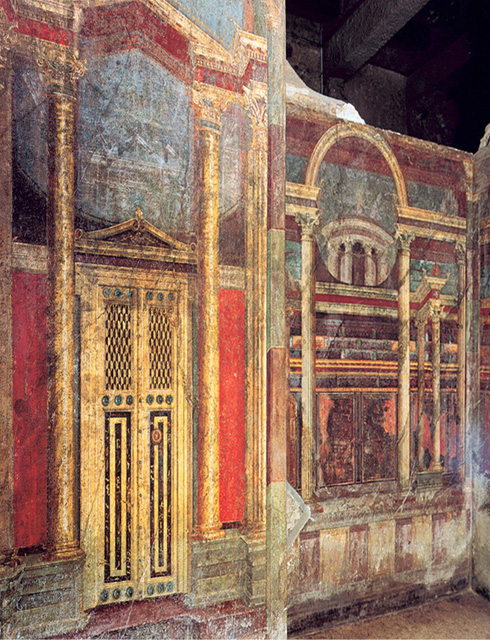The False-Door dissolution and becoming in Roman Wall-Painting is an ongoing investigation into domestically located paintings produced within the context of Italo-Roman culture, from approximately 100 BC to 200 AD. The various research strands contained in the investigation are mapped out in the introduction and examined in greater detail in the material that follows.
When this investigation began The False-Door was a factual reference to the recurring door motifs found in Roman wall-painting. The subtitle dissolution and becoming signified the negation of planar space and the pictorial redefining of domestic walls into virtual realities. As the investigation progressed the title took on a second meaning concerned with the way in which every generation creates perceptual doors or filters through which it views the past. Back to the Present and The Neoclassicising of Pompeii is concerned with this theme, whilst Roman Painting and Film Culture examines the way in which the despotic, orgiastic and idolatrous image of Rome is largely the result of screen cultures, which have transformed it into spectacle for purely entertainment purposes. In contrast, the remaining chapters examine ancient visual sources such as wall-paintings and mosaics that tell a very different story, one in which the deranged licentiousness that underpins much of Rome’s ‘Hollywoodisation’ is nowhere to be seen. Instead, we find sophisticated depictions of a world in which gods are revered and worshiped, family ancestors are commemorated, filial piety and affection is freely given and received, tragedy is confronted, moral fortitude is praised and profound love and passion is openly and sensitively displayed. Roman wall-painting in particular enables us to glimpse a society that bears little resemblance to its modern counterpart in contemporary popular culture.
In Rome, Naples et Florence (1817) Stendhal likened the eighteenth century discovery of Pompeii and Herculaneum to the finding of a time capsule capable of transporting us back into antiquity. The extent to which it plunged the modern world back in time may have surprised even Stendhal. Between Friedrich Furchheim’s 1891 Bibliografia di Pompei and the 1998 publication of Nova Bibliotheca Pompeiana, books and pamphlets on Pompeii increased from five hundred to over fourteen thousand. Several hundred more have been added since 1998. A significant part of the time capsule consisted of numerous wall-paintings, many of which were surprisingly well preserved by the volcanic debris that buried Pompeii and Herculaneum in 79AD.

|